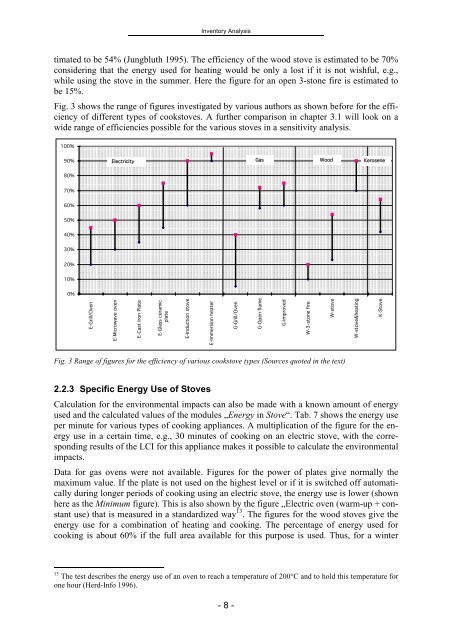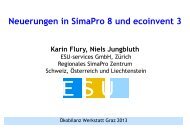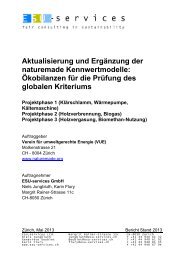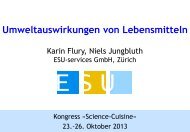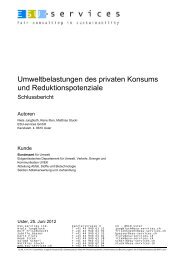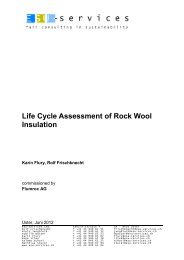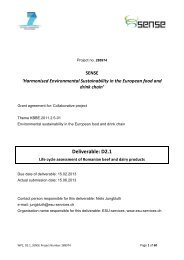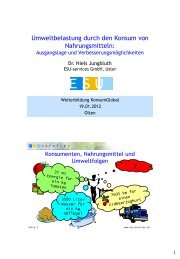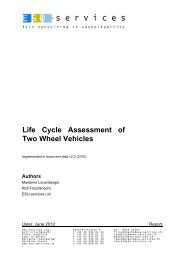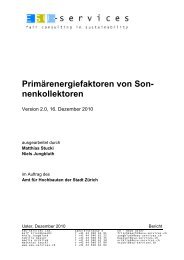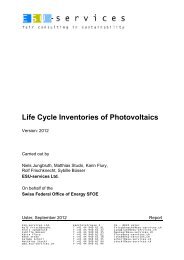Life-Cycle-Assessment for Stoves and Ovens - ESU-services Ltd.
Life-Cycle-Assessment for Stoves and Ovens - ESU-services Ltd.
Life-Cycle-Assessment for Stoves and Ovens - ESU-services Ltd.
You also want an ePaper? Increase the reach of your titles
YUMPU automatically turns print PDFs into web optimized ePapers that Google loves.
Inventory Analysis<br />
timated to be 54% (Jungbluth 1995). The efficiency of the wood stove is estimated to be 70%<br />
considering that the energy used <strong>for</strong> heating would be only a lost if it is not wishful, e.g.,<br />
while using the stove in the summer. Here the figure <strong>for</strong> an open 3-stone fire is estimated to<br />
be 15%.<br />
Fig. 3 shows the range of figures investigated by various authors as shown be<strong>for</strong>e <strong>for</strong> the efficiency<br />
of different types of cookstoves. A further comparison in chapter 3.1 will look on a<br />
wide range of efficiencies possible <strong>for</strong> the various stoves in a sensitivity analysis.<br />
100%<br />
90%<br />
80%<br />
70%<br />
60%<br />
50%<br />
40%<br />
30%<br />
20%<br />
10%<br />
0%<br />
<br />
<br />
<br />
<br />
<br />
<br />
<br />
<br />
<br />
<br />
<br />
<br />
<br />
<br />
<br />
<br />
<br />
<br />
<br />
<br />
<br />
<br />
<br />
<br />
<br />
<br />
<br />
<br />
<br />
<br />
<br />
<br />
<br />
<br />
<br />
<br />
<br />
<br />
<br />
<br />
<br />
<br />
<br />
<br />
<br />
<br />
<br />
<br />
<br />
<br />
<br />
<br />
<br />
<br />
<br />
<br />
<br />
<br />
<br />
<br />
<br />
<br />
<br />
<br />
<br />
<br />
<br />
E-Grill/Oven<br />
Electricity Gas Wood Kerosene<br />
E-Microwave oven<br />
E-Cast Iron Plate<br />
E-Glass ceramic<br />
plate<br />
E-Induction stove<br />
Fig. 3 Range of figures <strong>for</strong> the efficiency of various cookstove types (Sources quoted in the text)<br />
2.2.3 Specific Energy Use of <strong>Stoves</strong><br />
E-Immersion heater<br />
Calculation <strong>for</strong> the environmental impacts can also be made with a known amount of energy<br />
used <strong>and</strong> the calculated values of the modules „Energy in Stove“. Tab. 7 shows the energy use<br />
per minute <strong>for</strong> various types of cooking appliances. A multiplication of the figure <strong>for</strong> the energy<br />
use in a certain time, e.g., 30 minutes of cooking on an electric stove, with the corresponding<br />
results of the LCI <strong>for</strong> this appliance makes it possible to calculate the environmental<br />
impacts.<br />
Data <strong>for</strong> gas ovens were not available. Figures <strong>for</strong> the power of plates give normally the<br />
maximum value. If the plate is not used on the highest level or if it is switched off automatically<br />
during longer periods of cooking using an electric stove, the energy use is lower (shown<br />
here as the Minimum figure). This is also shown by the figure „Electric oven (warm-up + constant<br />
use) that is measured in a st<strong>and</strong>ardized way 13 . The figures <strong>for</strong> the wood stoves give the<br />
energy use <strong>for</strong> a combination of heating <strong>and</strong> cooking. The percentage of energy used <strong>for</strong><br />
cooking is about 60% if the full area available <strong>for</strong> this purpose is used. Thus, <strong>for</strong> a winter<br />
13 The test describes the energy use of an oven to reach a temperature of 200°C <strong>and</strong> to hold this temperature <strong>for</strong><br />
one hour (Herd-Info 1996).<br />
G-Grill/Oven<br />
- 8 -<br />
G-Open flame<br />
G-Improved<br />
W-3-stone fire<br />
W-stove<br />
W-stove&heating<br />
K-Stove


